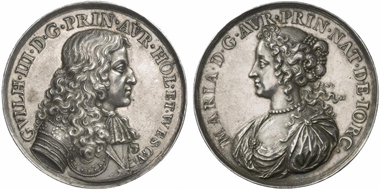by Björn Schöpe
courtesy of Barbara Balz / World Money Fair
At the first glance, this marriage looks perfectly normal: Mary Stuart, niece of the King of England, marries William III of Orange, Stadtholder of the Netherlands. This union of two dynasties is celebrated by Mary’s uncle with a splendid medal. For the contemporaries, however, there was much more to that event – and its consequences were tremendous.
Charles II (1660-1685). Silver medal, no year, by N. Chevalier on the marriage of Mary II and William III of Orange (1677). Eimer 256. From Künker auction 183 (2011), 1723.
In the years before the marriage, the political situation in England had been complicated: Except for Charles II and Mary, his niece, almost all members of the royal family were Catholic. The Anglican subjects felt how the hand of the Pope, whom they abhorred, reached out for their country. The king had to exclude his brother from succession, by which he appointed the Protestant Mary as the next queen. For the Anglicans, the prospect of a non-Catholic future made the present easier to bear, as well.
King James II of England. Nicolas de Largillière, 1686. Source: Wikipedia.
But things turned out differently after Charles’ death. His younger brother James ascended to the throne without meeting any resistance. His position seemed secure. A standing army and safe revenues left no doubt that the Catholic king firmly held the reins of power. Also in foreign policy, England played safe, being allied to France, the most powerful country in Europe. Paradoxically, it was this very constellation that led to James’ deposition and the so-called Glorious Revolution.
By many in England, James’ policies were perceived as the feared attempt to re-Catholicise the country and impose absolute rule. Thus, in a secret letter, a group of nobles invited William III of Orange, the husband of Mary – niece of King Charles II and heiress presumptive –, to take over from James as king. The Dutch prince seized the opportunity, allegedly on grounds of succession rights. As a matter of fact, William, leader of Protestantism, had realised how he could weaken his arch-enemy, the Catholic king of France: By “taking over” England.
Favourable winds allowed to cross over to England in the middle of winter 1688. James left the country without putting up any resistance and sought refuge in France. In an unusual double coronation ceremony William and Mary were jointly crowned King and Queen of England on 11 April 1689. Parliament had succeeded in securing important concessions, and the advocates of a parliamentary system saw that as a Glorious Revolution. In fact, there had been no bloodshed, but the process could hardly be called revolutionary. England continued to have a monarch who would always have to negotiate the balance of power anew.
This article was written for the catalogue of the World Money Fair 2012 whose Guest of Honour was Great Britain. More on the World Money Fair 2012 you can read here.







